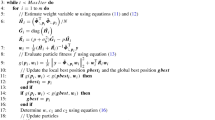Abstract
Many researches have been devoted to select the kernel parameters, including the centers, kernel width and weights, for fault-free radial basis function (RBF) neural networks. However, most are concerned with the centers and weights identification, and fewer focus on the kernel width selection. Moreover, to our knowledge, almost no literature has proposed the effective and applied method to select the optimal kernel width for faulty RBF neural networks. As is known that the node faults inevitably take place in real applications, which results in a great many of faulty networks, it will take a lot of time to calculate the mean prediction error (MPE) for the traditional method, i.e., the test set method. Thus, the letter derives a formula to estimate the MPE of each candidate width value and then use it to select the optimal one with the lowest MPE value for faulty RBF neural networks with multi-node open fault. Simulation results show that the chosen optimal kernel width by our proposed MPE formula is very close to the actual one by the conventional method. Moreover, our proposed MPE formula outperforms other selection methods used for fault-free neural networks.
Similar content being viewed by others
References
Park J, Sandberg I (1993) Approximation and radial-basis function networks. Neural Comput 5: 305–316
Orr MJL (1996) Introduction to radial basis function networks. Technical reports. www.anc.ed.ac.uk/~mjo/papers/intro.ps
Bishop CM (1995) Neural networks for pattern recognition. Oxford University Press, Oxford
Chen S, Cowan CFN, Grant PM (1991) Orthogonal least squares learning algorithm for radial basis function networks. IEEE Trans Neural Netw 2(2): 302–309
Masashi S, Hidemitsu O (2001) Subspace information criterion for model selection. Neural Comput 13(8): 1863–1889
Haykin S (1999) Neural networks a comprehensive foundation, 2nd edn. Prentice-Hall Inc., Upper Saddle
Moody J, Darken CJ (1989) Fast learning in networks of locally-tuned processing units. Neural Comput 1: 281–294
Lázaro M, Santamaría I, Pantaleón C (2003) A new EM-based training algorithm for RBF networks. Neural Netw 16: 69–77
Benoudjit N, Verleysen M (2003) On the kernel widths in radial-basis function networks. Neural Process Lett 18(2): 139–154
Bolt GR (1991) Fault models for artificial neural networks, pp. 1371–1378
Murray AF, Edwards PJ (1994) Enhanced MLP performance and fault tolerance resulting from synaptic weight noise during training. IEEE Trans Neural Netw 5: 792–802
Zhou Z, Chen S (2003) Evolving fault-tolerant neural networks. Neural Comput Appl 11: 156–160
Bernier JL et al (2003) Assessing the noise immunity and generalization of radial basis function networks. Neural Process Lett 18(1): 35–48
Moody J (1994) Prediction risk and architecture selection for neural networks. From statistic to neural networks: theory and pattern recognition application. NATO ASI Series F, Springer-Verlag, New York
Moody J (1991) Note on generalization, regularization and architecture selection in nonlinear learning systems. In: Juang BH, Kung SY, CA Kamm (eds) Neural networks for signal processing. IEEE Press, Piscataway, pp 1–10
Leung CS, Young G, Sum J, Kan W (1999) On the regularization of forgetting recursive least square. IEEE Trans Neural Netw 10: 1482–1486
Leung CS, Tsoi AC, Chan LW (2001) Two regularizers for recursive least squared algorithms in feedforward multilayered neural networks. IEEE Trans Neural Netw 12(6): 1314–1332
Leung CS, Sum J (2008) A fault-tolerant regularizer for RBF networks. IEEE Trans Neural Netw 19(3): 493–507
Murray AF, Edwards PJ (1994) Enhanced MLP performance and fault tolerance resulting from synaptic weight noise during training. IEEE Trans Neural Netw 5: 792–802
Phatak D, Koren I (1995) Complete and partial fault tolerance of feedforward neural nets. IEEE Trans Neural Netw 6: 446–456
Sum J, Leung CS, Ho K (2009) On Objective function, regularizer and prediction error of a learning algorithm for dealing with multiplicative weight noise. IEEE Trans Neural Netw 20(1): 24–138
Fedorov VV (1972) Theory of optimal experiments. Academic Press, New York
Chen S, Hong X, Harris CJ, Sharkey PM (2009) Sparse modeling using orthogonal forward regression with press statistic and regularization. IEEE Trans Syst Man Cybern B 34: 898–911
Mackey M, Glass L (1977) Oscillation and chaos in physiological control systems. Science 197(4300): 287–289
Chen S (2006) Local regularization assisted orthogonal least squares regression. Neurocomputing 69(4C6): 559–585
Author information
Authors and Affiliations
Corresponding author
Rights and permissions
About this article
Cite this article
Wang, HJ., Leung, CS., Sum, PF. et al. Kernel Width Optimization for Faulty RBF Neural Networks with Multi-node Open Fault. Neural Process Lett 32, 97–107 (2010). https://doi.org/10.1007/s11063-010-9145-x
Published:
Issue Date:
DOI: https://doi.org/10.1007/s11063-010-9145-x




